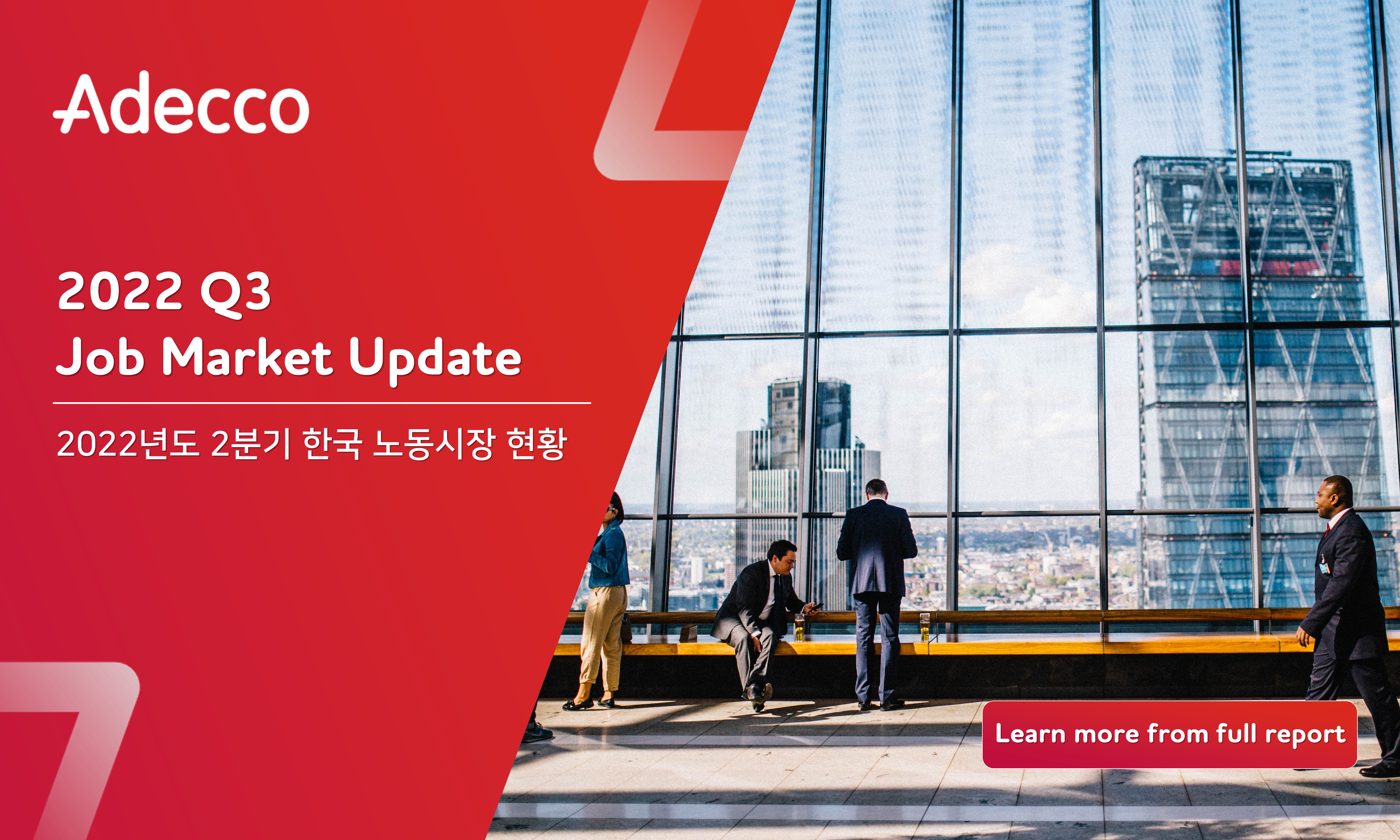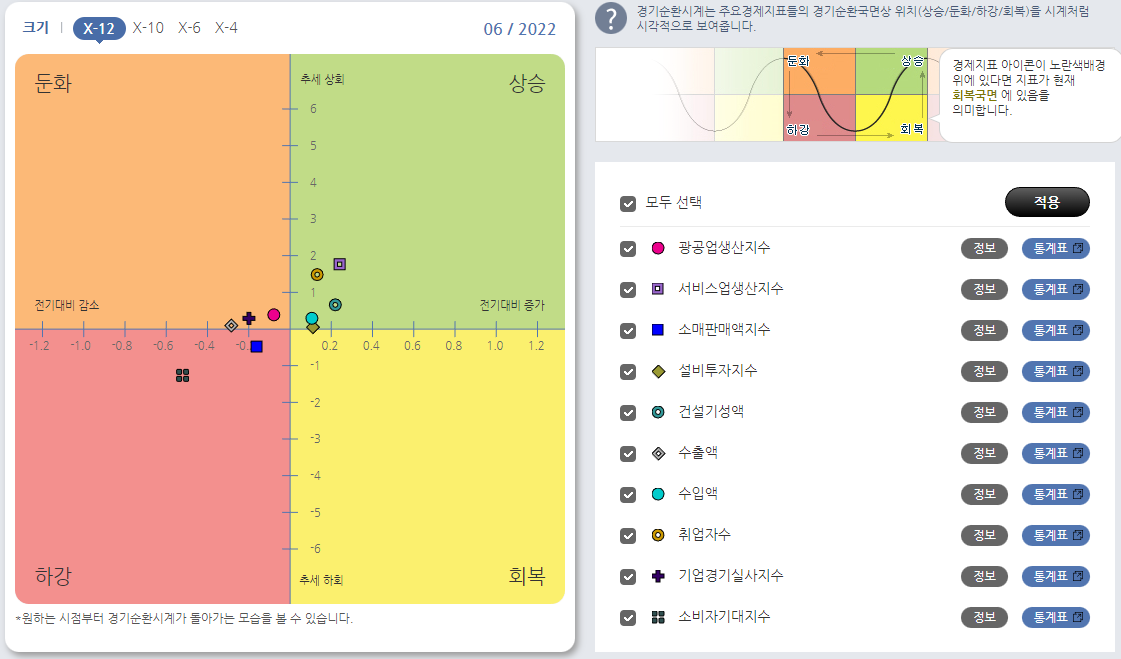[Job Market Update] 2022 Q3

 2022년 – 제2분기 한국의 고용시장
2022년 – 제2분기 한국의 고용시장
한국은 수출 지향적 경제 시스템을 가지고 있으며 서비스 부문이 국내총생산(GDP)의 가장 큰 비중을 차지하고 있습니다. 한국 국가통계포털의 [이하 “KOSIS”라 함] 최근 통계자료에 따르면, 2022년 6월 현재 경제활동인구와 노동력 인구비율은 각각 전년대비 2.2%와 1.2% 증가했으며, 재무부는 코로나 오미크론 변이위험의 감소에 따라 고용이 이전 추정치인 280,000명의 두 배 이상인 600,000명까지 증가할 것으로 예상하고 있습니다.
한국의 고용률과 국내수요는 계속해서 증가하고 있습니다. 그러나, 인플레이션이 세계경제를 위협할 것이라는 각국의 중앙은행의 예측을 고려했을 때, 금년 한국경제는 정부의 사전예측과 비교해 더 느린 속도로 확장할 것으로 예상됩니다. 한국의 소비자 물가는 5월에 2008년 이래로 가장 높은 수준인 5.4% 상승했으며, 2분기 전체에 걸쳐 5% 범위를 유지할 것으로 예상되고 있습니다.
올해 3월 윤(석열) 대통령 선출 이후 새 정부가 활발한 경제 활성화 정책들을 시행중인 가운데, 지난 5월 한국정부가 통과시킨 기록적인 수준의 추경예산은 물가상승의 경제 위기상황에서 팬데믹의 경제적 여파를 상쇄하기 위한 국가의 마지막 세제지원이 될 것으로 보여집니다.
국가통계포털(KOSIS)에서 제공하는 5월의 경기순환시계에 따르면, 서비스부문과 건설기성액, 고용인구는 확장 단계에(녹색 사분면) 위치하고 있는 반면 산업생산, 수출, 수입, 기업경기실사지수(BSI)는 경기둔화 단계에(오렌지색 사분면), 소매매출, 시설투자, 소비자 기대지수는 경기후퇴의 단계에(붉은색 사분면) 위치하고 있는 것으로 보여집니다. 지난 4월 자료와 비교했을 때, 서비스부문과 건설기성액, 고용인구는 증가한 반면에 산업생산, 소매 매출, 수출, 수입, 기업경기실사지수(BSI), 소비자 기대지수는 감소했습니다.

Reference: https://kosis.kr/visual/bcc/index/index.do?language=eng
국내외 난제들에 직면한 가운데 견실하지만 완만하게 회복중인 한국경제
한국경제상황에 대해, 아데코코리아 브라이언 대표이사(Bryan Luro)는, 경제지표에서도 보여지듯이 “한국경제는 몇가지 경제 위험요소를 직면한 가운데, 견실하지만 완만하게 회복중이다” 라고 언급했습니다. Bryan 대표이사는 한국의 추정국내총생산(GDP)증가율과 실업률이 모두 약 3% 정도로, 수출사업이 현재 한국의 경제회복을 주도하고 있으며, 특히 반도체 산업군의 역할이 크다고 강조했습니다.
그러나, 최근 가스공급에 문제가 발생하면서, 가스가 한국의 수출전망을 어둡게 하는 요인으로 간주되고 있습니다. 한국정부는 최근 러시아산 가스구매를 대폭 감소시키고 가스의 공급선을 미국과 중동으로 전환시켰으며, 국가 간의 무역, 물류, 법률 및 금융적 문제들을 방지하기 위해 러시아산 원유구매 또한 결국에 중지할 것으로 전망됩니다. 전 세계적인 러시아산 가스와 원유의 수입중지는 국제적인 화석에너지 부족을 야기하게 될 것이며 국제 공급망에도 영향을 미칠 것입니다. 이에, Bryan대표이사는 세계적인 가스와 원유 부족상황이 공급가격상승을 도래하고 그에 따라 수출물량이 감소할 것이며, 수출에 크게 의존하고 있는 한국경제의 회복속도를 둔화시킬 것이라고 지적했습니다.
Bryan대표이사는 두 번째 위험요소에 대해 “한국현지의 문제” 라고 표현하며 국가 내부의 인구통계적 문제를 설명했습니다. 그는 인구통계적 변화가 미래 한국 경제환경을 결정짓는 불가피한 요소가 될 것이라고 말하며, “오늘날은 문제가 안될 수 있지만, 3년에서 10년 뒤, 즉, 2025년에서 2030년까지 내다본다면, 낮은 출산율이 한국의 심각한 경제활동인구 부족을 야기하게 될 것이다” 라고 언급했습니다. 또한 그는 2025년 추정치에 따르면 한국에서 활동인구가 1백만명에서 1백5십만명 부족하고 2030년에는 3백만명에서 3백5십만명 부족하게 될 것이라 예측한다고 덧붙였습니다.
한국경제에 영향을 미치는 또 다른 내부적 요인은 정치적인 것입니다. Bryan은 올해 3월 진행된 대통령 선거의 세대별, 성별, 지역별 결과를 보며 나라가 “반으로 갈라졌다” 관측했다고 말했습니다. 그는 현재 한국사회가 구세대와 신세대 사이의 갈등을 직면하고 있는데, 이 갭을 줄이고 화합을 이루는 것이 앞으로 한국사회에 주어진 도전과제일 것이라 덧붙였습니다.
아데코코리아의 General Staffing Division 본부장(Larry Jung) 또한 변화하는 한국의 경제상황, 고용시장현황에 대해 “한국정부가 현재 미국정부와의 정치적 유대관계를 형성하는 방향으로 나아가고 있으며, 이런 정치적 성향은 투자와 개발전략에 많은 영향을 미치게 될 것입니다.” 라는 의견을 더했습니다.
더불어, 계속 진행중인 팬데믹과 관련하여서는, Bryan과 Larry모두 아직 코로나19 팬데믹이 한국시장에 경제적 영향을 미치고는 있으나, 크게는 걱정하지 않는다고 하였습니다.
구직자들을 위한 산업의 전망
국내외 직면한 여러 난제 들에도 불구하고, 한국에는 꾸준히 성장하고 있는 산업군들이 존재합니다. 비록 호황기는 아니지만 제조산업이 현상을 유지하고 있는 한편, Bryan은 최고 호황산업 1위로 반도체 산업을 손꼽았으며, 우수한 성과를 유지하고 있는 E-commerce와 공급망부문을 포함한 물류산업을 2위 호황산업으로 지칭했습니다. 또한 그는, 6월에 건설산업이 부상했으나 지금은 하강했다고 언급하며, 건설관련 프로젝트들도 다시 상승세를 타고 있으나 새로운 행정부가 아직 두 달 밖에 집권을 하지 않았기 때문에 그 영향을 받기는 어려울 것이라고 덧붙였습니다.
Bryan은 아데코 같은 경우, 채용요청이 많은 산업군에 투자를 하고 있기 때문에 어떤 산업군의 인력수요가 증가하는지 감소하는지 확인할 수 있는 좋은 지표가 된다고 말하며, 지난 2년간 아데코에서 가장 빠르게 성장한 부서는 반도체, 에너지 발전기술, 인공지능, 스마트 비즈니스 관련 분야의 채용을 담당하는 엔지니어링 부서라고 언급했습니다. 반면, Bryan은 팬데믹 영향으로 관광객이 감소하면서 소비자시장과 접객산업, 여행산업 및 여행산업과 관련된 모든 산업군의 수요가 감소하고 있다고 지적했습니다. 이에, Larry는 팬데믹의 영향으로 특히 은행산업의 도급수요가 감소한 반면 여행산업의 경우, 현재 한국이 국경을 열고 관광객을 유치하는 추세이기 때문에 시간에 걸쳐 점진적으로 해당산업군의 회복이 예측된다고 덧붙였습니다.
채용을 전문으로 하는 인사전문가로서 Bryan과 Larry는 구직자들이 이제는 다방면에 적당한 지식을 가지기보다, 특정한 분야의 전문가가 될 수 있도록 노력하고 준비해야한다고 조언했습니다. 즉, 현재 채용수요가 많은 IT기술관련 엔지니어의 경우, 현재 고용여부에 상관없이 회사 대내외 다양한 채널을 통해서 직무에 필요한 기술을 배우고 스스로의 역량을 확대할 필요가 있다는 것을 의미합니다. 더불어, 현재 한국 채용 트랜드에 대해, Larry는 많은 기업에서 중요 업무를 수행하는 직원들 만을 채용하고 그 외의 업무는 외주로 전환하는 식의 채용 트랜드를 보이고 있다고 언급했습니다. 이는 구직자들에게 있어서, 정규직 채용보다 계약직 채용이 더 일반적인 옵션이 되고 있다는 것을 의미할 수 있습니다.
오는 3분기를 내다보면서, Bryan은 지난분기와 비교해 전반적인 시장 트랜드나 특정 산업군에 있어 큰 변화는 기대하지 않는다고 말하며, 변화가 있다면 정부에서 진행하는 프로젝트가 주요인이 될 것이며, 정부투자 여부에 따라 부상하는 산업군이 결정될 것이라고 언급했습니다.


